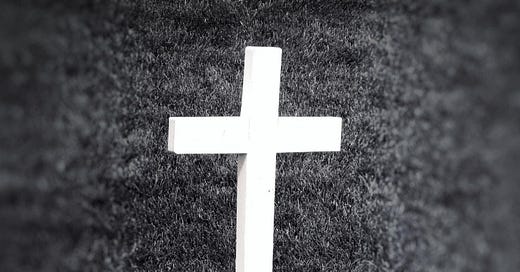It was the day before Mother’s Day. She was never a mother. Her ashes were buried atop her parents, a small white cross bearing the words “I’m free” marking her addition to their resting place.
She was one of ten siblings. Number six, six years younger than her next sibling, three older than the one after.
The first to die. She was fifty-nine.
Six of her brothers and sisters were present, the other three streaming in via a tablet from distant places, a few of the in-laws and children, great-nieces and nephews. An elderly uncle and aunts.
“She jumped the queue,” her uncle said. He told a story to demonstrate her sense of humour. Stuck in the door of their mobile home because she was too wide to get out, having forgotten she had hauled herself in sideways. She thought it hilarious. More likely, she was mortified and covering her embarrassment with humour.
While I listened to the few speaking about her, I was struck by how little they knew her. There were no friends present to share who she was as a woman. No bereaved loved one. No one from her life in London during her thirties and forties.
They spoke of her sense of humour, of her childhood, playing songs she chose, a snippet of a rarely seen, lively, happy person.
I wondered what regrets she had, what she’d done and felt unable to share with her family. She was a number. Number six. They loved her, but I got the impression none of them knew who she really was. I certainly didn’t.
It was the saddest funeral I’ve ever attended and a potent reminder to live, love, and connect.
In case you’re wondering, she died of bone cancer. She was my cousin.
Unfortunately, a life of poor diet and no movement beyond the barest essentials created a potent cocktail of medical maladies. I looked around at the other family members at that funeral, heard the catalogue of medications and physical complaints, and saw people aged well beyond what their birth dates suggested. It’s likely most of them will live with increasing reliance on drugs and die younger than they otherwise would.
It’s heartbreaking.
It’s not genetic. According to long-term studies across hundreds of thousands of people worldwide, genetics plays a minor role in determining health outcomes.
It’s what this family, and millions like it, are eating, drinking, and smoking. It’s a lack of movement and too much stress.
It’s completely unnecessary and preventable, and very few people want to hear this, which is the biggest heartbreak of all. Most people would prefer to continue eating poorly, drinking alcohol, and popping pills rather than rejoice in the fact that they can improve their health, live longer and more vibrantly by changing their lifestyles and diets.
When I looked around at my cousins and talked to them afterwards, their physical and mental health complaints were a reminder of the path I was on for most of my life. I saw that path so clearly and knew where it ended, with a white cross at an early age, after some vile disease ravaged my body, or my heart just couldn’t cope any longer.
Six years ago, sitting in pain on a sofa, I saw that exact path, and it was terrifying. I could barely walk due to the pain in my left hip. Arthritis had eaten away the joint, and I walked with a cane, unable to pull up my own pants. I was forty-nine.
Unable to hike in nature, which was my means of de-stressing, I’d spiralled once again into depression, an old familiar hiding place.
Despite all this, I knew there had to be a way to change course. I ended up having my hip joint replaced because it was beyond recovery, and I started researching, going back through material I’d accumulated over a lifetime of ill health and injuries, and searching for more answers online in medical research from across the globe, in alternative healing, and with psychologists.
It’s taken all of those intervening years to completely change the trajectory of my life, but I’m now a different person.
As the saying goes, a one-degree shift in a ship’s course will send it to a new location and with just one small step at a time, you can create a new path. It’s true.
I’m forty-odd kilos lighter, much fitter, stronger, and as flexible as ever. The ways in which I manage stress and my high sensitivity are totally different. I had no idea I was highly sensitive when I started down this path, let alone how to manage the effects and bring my nervous system into balance.
It’s possible to live pain-free. Go figure. Pain was a constant for the first fifty-odd years of my life and now there’s an occasional niggle, one or two old injuries still healing, but the increasing arthritis pain in my joints has disappeared and I’m basically pain-free.
I feel sad for my cousin, for the life and opportunities lost. I’m also grateful for the reminder to embrace the lifestyle I’ve created, to love and live fully.
Choosing a healthy lifestyle needn’t mean abandoning everything you’ve ever known and wiping the slate clean. It’s about taking small steps, tweaking your diet, moving more, looking at what drives your behaviours and finding ways to increase joy. Reduce unnecessary stress and learn to manage the effects of the stressors you cannot remove.
Too many people are dying far too young, and many more are living a half-life, plagued by preventable and curable conditions, reliant on increasing medications.
The summation of a life in a small white cross. “I’m free.” I hope she finds the peace and joy she deserves. She’s inspired me to continue walking a different path.




